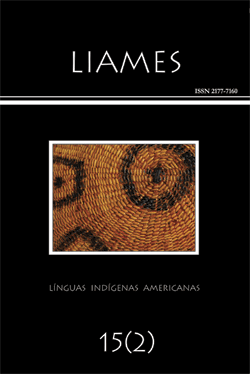Abstract
The origins of the Mayna language, formerly spoken in northwest Peruvian Amazonia, remain a mystery for most scholars. Several discussions on it took place in the end of the 19th century and the beginning of the 20th; however, none arrived at a consensus. Apart from an article written by Taylor & Descola (1981), suggesting a relationship with the Jivaroan language family, little to nothing has been said about it for the last half of the 20th century and the last decades. In the present article, a summary of the principal accounts on the language and its people between the 19th and the 20th century will be given, followed by a corpus analysis in which the materials available in Mayna and Kawapanan, mainly prayers collected by Hervás (1787) and Teza (1868), will be analysed and compared for the first time in light of recent analyses in the new-born field called Kawapanan linguistics (Barraza de García 2005a,b; Valenzuela-Bismarck 2011a,b , Valenzuela 2013; Rojas-Berscia 2013, 2014; Madalengoitia-Barúa 2013; Farfán-Reto 2012), in order to test its affiliation to the Kawapanan language family, as claimed by Beuchat & Rivet (1909) and account for its place in the dialectology of this language family.
References
Barraza de García, Yris Julia (2005a). El sistema verbal en la lengua shawi. Tese de doutorado em Linguística. Universidade Federal de Pernambuco. Available at: http://www.repositorio.ufpe.br/bitstream/handle/123456789/7747/arquivo8448_1.pdf?sequence=1&isAllowed=y
Barraza de García, Yris Julia (2005b). ¿Es la lengua Shawi una Lengua Activa? Memorias del Congreso de Idiomas Indígenas de Latinoamérica-II. Universidad de Texas en Austin. Available at: http://www.ailla.utexas.org/site/cilla2/Barraza_CILLA2_shawi.pdf
Beuchat, Henri; Rivet, Paul (1909). La famille linguistique Cahuapana. Zeitschrift für Ethnologie . Número 41: 616-634.
De Figueroa, Francisco (1986[1661]). Informe de las Misiones en el Marañón, Gran Pará o Río de las Amazonas. In Informes de jesuitas en el Amazonas (F. Figueroa et al.) Iquitos: CETA. Col. Monumenta Amazónica.
Farfán Reto, Harold (2011). Clasificadores en shiwilu (jebero): organización semántica y morfosintáctica. Tesis para optar por el grado de licenciado. Lima: Pontificia Universidad Católica del Perú. Available at: http://repositorio.pucp.edu.pe/index/handle/123456789/46147?show=full
Garra, Simone (2012). El despertar de Kumpanam: historia y mito en el marco de un conflicto socioambiental en la Amazonía. Anthropologica, año XXX, No 30: 5-28.
Hervás, Lorenzo (1787). Saggio Pratico delle lingue (Idea dell’Universo XXI). Cesena: Gregorio Biasini all’Insengna di Pallade.
Madalengoitia Barúa, María Gracia (2013). Bosquejo fonológico de la lengua jebero (shiwilu). Tesis de Licenciada en Lingüística y Literautura. Lima: Pontificia Universidad Católica del Peru. Available at: http://tesis.pucp.edu.pe/repositorio/bitstream/handle/123456789/5251/MADALENGOITIA_BARUA_MARIA_BOSQUEJO_JEBERO.pdf?sequence=1
O’hagan, Zachary (2013). Toponymic evidence for Mayna-Candoshi connection. Blog: Amazonian Adventures. Last time consulted: Jan 25th 2014. Link: http://amazonzach.blogspot.com/
Rivet, Paul; Tastevin, Constant (1931). Nouvelle contribution à l’étude du groupe Kahuapana. International Journal of American Linguistics 6(3/4/): 227-271.
Rojas-Berscia, Luis Miguel (2013). La sintaxis y semántica de las construcciones causativas en el chayahuita de Balsapuerto. Tesis para optar por el grado de Licenciado en lingüística. Lima: Pontificia Universidad Católica del Perú. Available at: http://tesis.pucp.edu.pe/repositorio/handle/123456789/4
?show=full
Rojas-Berscia, Luis Miguel (2015). A Heritage Reference Grammar of Selk’nam. Master Thesis. Nijmegen: Radboud Universiteit Nijmegen.
Rojas-Berscia, Luis Miguel; Ghâvami-Dicker, Sâm (2015). Teonimia en el Alto Amazonas, el caso de Kanpunama. Escritura y Pensamento, XVIII, 36: 117-146. Lima: Universidad Nacional Mayor de San Marcos.
Taylor, Anne-Christine; Descola, Philippe ( 1981). El conjunto Jívaro en los comienzos de la conquista española del Alto Amazonas. Bulletin de l’Institut français d’Études Andines 10(3/4): 7-54.
Tessmann, Günter (1930). Die Indianer Nordost-Perus. Hamburg: Friedrichsen, de Gruyter.
Teza, Emilio (1868). Saggi inediti di lingue americane. Pisa: Annali dell’università di Pisa, X.
Valenzuela, Pilar M. (2011a). Argument encoding and pragmatic marking of the transitive subject in Shiwilu(Kawapanan). International Journal of American Linguistics 77(1): 91-120.
Valenzuela Bismarck, Pilar (2011b). Contribuciones para la reconstrucción del protocahuapana: Comparación léxica y gramatical de las lenguas jebero y chayahuita. In Willem F.H. Adelaar; Pilar Valenzuela Bismarck; Roberto Zariquiey Biondi (eds.). In Estudios sobre lenguas andinas y amazónicas. Homenaje a Rodolfo Cerrón-Palomino, pp. 271-304. Lima: Fondo Editorial Pontificia Universidad Católica del Perú.
Valenzuela, Pilar (2012). La lengua shawi. Retrieved from http://www.chapman.edu/wilkinson/_files/pdf/Shawintro.pdf
Valenzuela Bismarck, Pilar (2013). Diccionario Shiwilu-Castellano, Castellano-Shiwilu. Lima: FECONAJE.
Valenzuela, Pilar M. (2015). ¿Qué tan “amazónicas” son las lenguas kawapana? Contacto con las lenguas centroandinas y elementos para un área lingüística intermedia”. Lexis 39(1): 5-56. Lima: PUCP.
Veigl, Francisco Xavier (2006 [1798]). Noticias detalladas sobre el estado de la Provincia de Maybas en América meridional hasta el año de 1768. Iquitos: Centro de Estudios Teológicos de la Amazonía (CETA).
The LIAMES: Línguas Indígenas Americanas uses the Creative Commons license (CC), thus preserving the integrity of the articles in an open access environment.


